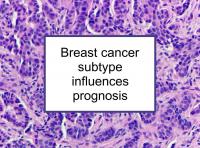A new study has reported that five-year outcomes among women who receive neoadjuvant chemotherapy for breast cancer are influenced by breast cancer subtype and whether the chemotherapy achieves a pathologic complete response (i.e., no microscopic evidence of viable cancer cells in tumor specimens removed during surgery).
Neoadjuvant chemotherapy takes place before surgery to remove the tumor whereas adjuvant chemotherapy takes place after surgery. Risk of recurrence in women who have adjuvant chemotherapy is known to be influenced by breast cancer subtype. In the current study, the authors report recurrence patterns according to breast cancer subtype following neoadjuvant chemotherapy.
The study included 331 patients who received neoadjuvant chemotherapy followed either by (1) lumpectomy and whole breast radiation (155 women); (2) mastectomy and radiation (122 women); or (3) mastectomy without radiation (50 women). Tumors were classified by immunohistochemical analysis into the following subtypes: luminal A (strong estrogen receptor positive (ER+) and progesterone receptor positive (PR+) and not HER2 overexpressing (HER2+)), luminal B (weak to moderate ER+/PR+ and HER2-), HER2 (HER2+), and triple negative/basal.
The women were followed for a median of 43 months for disease-free survival, locoregional recurrence (recurrence in the breast, chest wall, or lymph nodes), or distant recurrence.
Five-year disease-free survival was found to be 71.4% among women with luminal A breast cancer, 70.1% for luminal B, 70.4% for HER2, and 62.1% for triple negative/basal. The corresponding five-year locoregional recurrence rates were 3.8%, 1.6%, 1.3%, and 4.2%; the five-year distant recurrence rates were 25.8%, 28.7%, 28.7%, and 35.2%. Both molecular subtype and pathologic complete response predicted distant recurrence, disease-free survival, and overall survival. Locoregional recurrence was predicted only by the omission of radiotherapy following mastectomy.
The authors conclude that breast cancer subtype and pathologic complete response predict distant failure, disease-free survival, and overall survival in women who receive neoadjuvant chemotherapy. More work is needed to determine whether subtype can predict patients at risk for locoregional recurrence.
